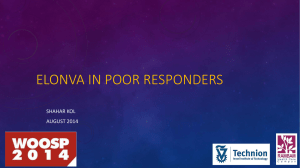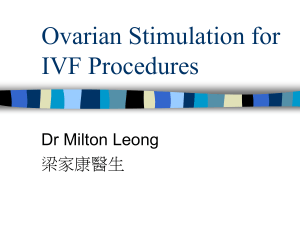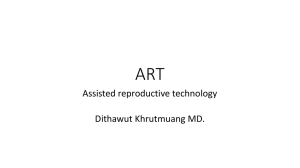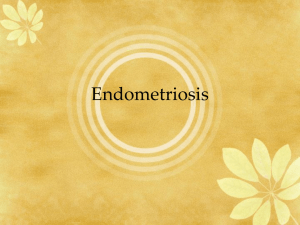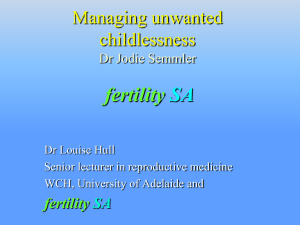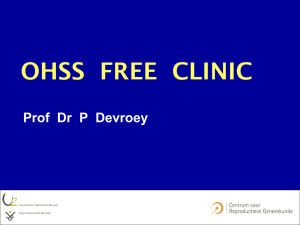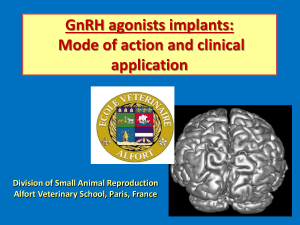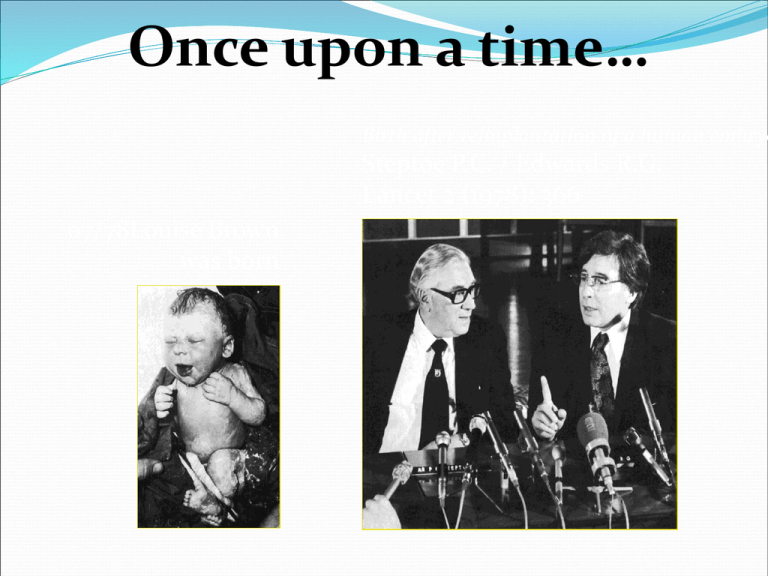
Once upon a time…
Birth after reimplantation of a human embryo
Steptoe P.C. / Edwards R.G.
Lancet 2 (1978): 366
07/78Louise Brown
was born
The hypothalamic-pituitary
endocrine system
15
brain
folliclestimulating
hormone (FSH)
pituitary
gland
oestrogen
ovary
oestrogen
uterus
Oestrogen
Primordial follicles
Primordial follicle is the earliest stage of
follicular development
Appears in the prenatal
Consists of oocyte surrounded by single layer of
squamous follicle cells
PRIMARY FOLLICLE
Appears in baby after he was born
Consists of oocyte surrounded by single layer of
squamous follicle cells
Histological appearance is like primordial
follicle
OVARY
CORTEX
MEDULA
Evaluation of Ovulatory Function
(Continued)
Enlarged ovarian follicle filled with fluid and a
mature ooctye
Image provided by author. Reprinted with permission. (Figure 4)
© 2008, March of Dimes
Foundation
Evaluation of Ovulatory Function
(Continued)
Mature oocyte
Image provided by author. Reprinted with permission. (Figure 5)
© 2008, March of Dimes
Foundation
Endometrial changes in luteal
phase
Glandular secretions – nutrients, enzymes, etc
Lumina epithelial surface – mucins etc
Within luminal epithelial cells – changes in functional
complexes, growth factors etc
History of ovarian stimulation
1970
Clomifen
hMG
1980
GnRH-agonist / hMG
1990
recFSH
GnRH-antagonist / hMG or
recFSH
2000
long acting FSH
G
Correction of ovulatory
dysfunction and supprtive
Prevention of OHSS
and multips
Luteal phase
support
How do we optimise??
Response assesment
Choice of protocol
Addition of other
measures
Ovulation Induction:
Clomiphene Citrate
• The “first line” of fertility therapy
• Used to treat mildly disordered ovulation and luteal-
phase insufficiency
• Establish tubal patency and sperm adequacy before
use.
XXXXXXXXXXXXXXXXX
• 17 10 2011 from ministry of health.
• Letrozole….
© 2008, March of Dimes
Foundation
Normogonadotropic, Normoprolactinemic,
Euthyroid women
(WHO class 2)
The primary indication
secondary to oligo ovulation or
Anovulation
polycystic ovary syndrome.
Hypergonadotropic women
(WHO class 3)
In contrast,
with FSH concentrations at or above
40 mIU/Ml ,
have diminished follicular reserve,
have little or
no response
to clomiphene.
Ovulation Induction: Clomiphene
Citrate
(Continued)
In appropriately selected patients,
• 80 percent ovulate and
• 40 percent conceive with clomiphene
•
(Imani, Eijkemans, te Velde, Habbema & Fauser, 1999).
• Cumulative conception rate is 60to 70%
•
(Dickey & Holtkamp, 1996).
© 2008, March of Dimes
Foundation
Monitering
Size of the follicles
Estradiol levels
LH
P4 surge
Ovulation Induction: Clomiphene
Citrate
(Continued)
• Multiples rate is about 10 percent
•
(Imani, Eijkemans, te Velde, Habbema & Fauser, 2002).
• After 6 months,
• women should move on to
• more aggressive therapy.
© 2008, March of Dimes
Foundation
What next
Gonadotropin injection
Pregnancy rate in one large NIH study
in control group 2% /cycle
In FSH plus IUI 9%,
with timed sex 4%
Another study pushed up the FSH+IUI to 26%
Injectable Gonadotropins
Mature ovarian follicles from gonadotropin
stimulation
© 2008, March of Dimes
Foundation
Ovarian response profile
•
•
•
•
•
•
Ovulatory potential
Hyper responder
Poor responder
Normal responder
Cyst former
Endometrial profile
• Changing profile – wt ,precycle drugs
natural course
Ovulation rate/ Cycle
Alt. dose vs Daily dose
40
40
38
35
30
29
25
25
20
19
19
15
15
13
10
5
0
50 35 24 17
Group-I
50 33 21 14
Group II
1st Cycle
2nd Cycle
3rd Cycle
4th Cycle
45
40
35
30
25
20
15
10
5
0
Group I
Group II
1st Cycle
2nd
Cycle
3rd
Cycle
4th Cycle
Fixed or flexible protocol
There was no statistically significant difference in
pregnancy rate between flexible and fixed protocols.
There was a statistically significant reduction in the
amount of recombinant FSH with the flexible
protocol.
CONCLUSION of this study
Study strongly suggests that a
alternate Day rec.FSH therapy is
equally effective as daily dose
therapy.
Risk of multiple pregnancies
and OHSS is less then daily dose
therapy and is cost effective.
How many FSH+IUI
3 cycles
6 cycles
Till patient withdraws?
1
www.ecosystema.ru/eng/
GnRH Antagonist //Long GnRH Agonist Cycles
FSH
Long Agonist
Protocol
FSH
Antagonist
Protocol
GnRH agonist
GnRH antagonist
Flare-up
LH
Pituitary
downregulation
Time
Reproduced with permission from Borm and Mannaerts. Hum Reprod. 2000;15:1490.
Adapted from Hodgen. Contemp Rev Obstet Gynaecol. 1990;35:10.
Direct
gonadotropin
suppression
GnRH-agonist and antagonist protocol
GOPU
LHRH-agonist: daily injection/ depot/ nasal spray
8
d -14
HCG
6
4
„long protocol“
Ampoules HMG
ET
2
Menses
0
-16 -14 -12 -10 -8 -6 -4 -2
0
4
6
8 10 12 14 16 17 day of cycle
antagonist
8
d6
HCG
6
„Lübeck
protocol“
2
OPU
4
ET
Ampoules
Gonadotropins
2
Menses
0
0
1
2
3
4
5
6
7
8
9 10 11 12 13 14 15 16 17 day of cycle
Complications of FSH use
Multiples
in follicles
in fetuses.
Prison sentence up to
three years or financial
penalty for
§ 1, Abs. 1, Nr. 3
„a person transfering more than
3 embryos to the womb in the
course of one treatment cycle“
§ 1, Abs. 1, Nr. 5
„a person fertilizing more oocytes
than he or she intends to tranfer in
the course of one treatment cycle“
Trigerring
3 or more follicles 17 mm
Expect cohort to be more heterogenous
Poor responders
Are always poor responders
No difference between flexible and fixed protocol
Cycle programming
Delay of trigger can be deleterious
No difference in CPR in a day of delay
25% vs 35%, on going pregnancy rate when trigerring 2
days vs 3 days after follicles are 17 mm respectively
Orgalutran Phase 3 Trials:
Duration of FSH Stimulation
Days of FSH stimulation
12
10
11
10
Buserelin
10
9
9
8
8
4
2
EU
trial
Out and Mannaerts. Hum Fertil. 2002;5:G5.
Leuprolide
Triptorelin
6
0
Orgalutran
NA
trial
EU/ME
trial
Orgalutran Phase 3 Trials:
Amount of recFSH Required
2,500
Orgalutran
Buserelin
IU of FSH required
2,025
2,000
1,500
1,800
1,800
1,800
Triptorelin
1,500
1,350
1,000
500
0
EU
trial
Out and Mannaerts. Hum Fertil. 2002;5:G5.
Leuprolide
NA
trial
EU/ME
trial
Orgalutran Phase 3 Trials: Number of Oocytes and
Oocytes
Good Quality
Good Quality
Embryos
Embyros
16
10
14.1
9
14
Leuprolide
7
9.7
9.6
8.7
7.9
8
6
Number
Number
10
Buserelin
8
11.7
12
Orgalutran
Triptorelin
6
4.8
5
4
4.3
3.3 3.5
2.7 2.9
3
4
2
2
1
0
0
EU
trial
NA
trial
EU/ME
trial
EU = European; NA = North American; ME = Middle East.
Out and Mannaerts. Hum Fertil. 2002;5:G5.
EU
trial
NA
trial
EU/ME
trial
Ongoing pregnancy rate (%)
Orgalutran Phase 3 Trials: Ongoing Pregnancy
Rate per Started Cycle
40
Orgalutran
36.4
33.9
35
30.8
31
30
25.7
20.3
20
15
10
5
EU
trial
Out and Mannaerts. Hum Fertil. 2002;5:G5.
Leuprolide
Triptorelin
25
0
Buserelin
NA
trial
EU/ME
trial
Ongoing pregnancy
rate per attempt (%)
Orgalutran vs GnRH Agonist:
If results from the 2 sites with outlier results are excluded, pregnancy
Success
Vary Between
Centers
rate
is similarRates
for antagonist
and agonist cycles
45
40
35
30
25
20
15
10
5
0
38 38.8
36.4
31.3
30.8
14.6
9 USA sites
(n=204)
2 Canadian sites
(n=93)
Overall
(n=297)
Values represent unadjusted means
Data on file, North American Ganirelix Study Group.
Orgalutran
Leuprolide
Ongoing pregnancy
rate per attempt (%)
Orgalutran vs GnRH Agonist: Success Rates Better in Centers
With Experience
40
30
24.2
27.6
25.7
23.6
16.5
20.3
Orgalutran
20
Buserelin
10
0
10 sites with
experience
10 sites without
experience
Overall
(n=363)
(n=700)
(n=337)
Values represent unadjusted means and SE.
Borm and Mannaerts. Hum Reprod. 2000;15:1490.
GnRH Antagonists Are Associated With More Favorable
Outcomes vs GnRH Agonists Among Women at High Risk for
OHSS
Investigator-driven, prospective observational study of women (N=87) at high risk for
OHSS, who were treated with a GnRH antagonist protocol following a previous cycle
with a GnRH agonist protocol
Percent
P=0.003
100
90
80
70
60
50
40
30
20
10
0
96.6
P<0.001
76.3
GnRH agonist
GnRH antagonist
67.8
P<0.001
56.3
43.7
P=0.006
32.2
27.6
11.5
Canceled
cycles
Ragni et al. Hum Reprod. 2005;20:2421.
Oocyte
retrievals
Embryo
transfer
OHSS
Endometrial abnormalities in
stimulated cycles
Advanced endometrial maturation by 2-4 days
This effect not seen if frozen embryos transferred in
natural cycle.
Antagonist vs Long GnRH Agonist: Effects on
the Endometrium
No relevant alteration in endometrial thickness
Endometrial dating, estrogen and progesterone receptor
expression, and endometrial surface structure were
unaffected
Agonist was associated with indications of an arrest in
endometrial development
Expression of “window of implantation” genes with
antagonist treatment more closely paralleled the pattern
observed during a natural cycle compared with agonist
Simon et al. Hum Reprod. 2005;20:3318.
Best Practices for GnRH Antagonist Protocols: Evidence Does
Not Support Supplementation of LH Activity
Bosch et al1
35
P=0.61
35
32.1
30
25
20
15
10
5
0
hMG recFSH
1. Bosch et al. Hum Reprod. 2008;23:2346.
2. Baruffi et al. Reprod Biomed Online. 2007;14:14.
40
Ongoing pregnancy rate (%)
Ongoing pregnancy rate (%)
40
Meta-analysis2
P=NS
35
30
31.7
29.5
25
20
15
10
5
0
recFSH recFSH
+ rLH
GnRH Antagonist Strategy Is Associated With
a Lower Dropout Rate vs Long GnRH Agonist Strategy
Likelihood of continuing therapy (%)
Continuation of therapy following each cycle
100
95.9%
90
93.7%
GnRH antagonist plus SET
GnRH agonist plus DET
88.3%
80
78.6%
70
60
75.9%
P=0.034
50
0
1
2
Cycle number
SET = single embryo transfer; DET = double embryo transfer.
Adapted from Verberg et al. Hum Reprod. 2008;23:2050.
3
GnRH Antagonist and Long GnRH Agonist
Strategies Result in Comparable
Cumulative Pregnancy Rates
% of pregnancies
leading to term live birth
Proportion of pregnancies leading to cumulative
term live birth within 12 months after starting IVF
60
GnRH agonist with DET
GnRH antagonist with SET
40
Singleton term
live birth
20
0
0
3
6
Months since randomization
Adapted from Heijnen et al. Lancet. 2007;369:743.
9
12
GnRH Antagonist and GnRH Agonist Strategies Result in
Shorter Treatment, Better Safety, and Lower Cost
GnRH
Antagonist
(n=444)
GnRH
Agonist
(n=325)
Days of injections
8.5
25.3
<0.0001
Days of stimulation
8.3
11.5
<0.0001
Total dose of FSH (IU)
1,307
1,832
<0.0001
Incidence of OHSS (%)
1.4
3.7
0.04
€8,333
€10,745
0.006
Mean total costs
Heijnen et al. Lancet. 2007;369:743.
P Value
The low dose protocol
Indication - PCOS patients
Start with 37.5u rFSH
Scan after a week
If no improvement increase by 37.5
Maintain dose if dominant follicle grows
Trigger with agonist
Low dose FSH protocol
Weekly increment if no increase in size
107
75
37.5 u
PCOS-The soft protocol solution
CC- D2- D5 days
D6 HMG/FSH 50-150 u /day
Lead follicle 13mm, or 6 follicles of 1.2,E2 400ng
Add antagonist 0.25mgm/day
Follicle – 17mm
Trigger -1mgm of agonist/HCG 5000iu
IUI or ART 36 hrs later
Cardone FS2003
Newer forms of isomers.
it is unlikely that isoforms of FSH with half-lives
longer than present preparations would have much
clinical application except for stimulation of
spermatogenesis. For induction of ovulation, a range
of products with relatively short half-lives would
permit more sensitive manipulation of the therapeutic
dose and facilitate achieving mono-ovulation. The
current preparations of FSH are likely to continue to
dominate clinical use for ovarian stimulation prior to
IVF.
Stimulation of follicle development with FSH preparation of differing half-lives (t1/2) to
achieve ovulation of a single follicle (Adapted from Baird, 1993).
Baird D T Hum. Reprod. 2001;16:1316-1318
© European Society of Human Reproduction and Embryology
long acting FSH
follicle aspiration
after 36h
FSH-CTP
10000
IE hCG
1
2
3
4
5
6
7
8
9
10
11
12
13
GnRH-Antagonist
LF 10 mm
LF 14 mm
LF 17mm
14 ….
Ovarian
Cortical Strips
Transplantation
Dr Muhammad El Hennawy
Ob/gyn specialist
59 Street - Rass el barr –dumyat - egypt
www.mmhennawy.8m.com
Mobile 0122503011
Orthotopic Whole Fresh Ovary
Microsurgical Transplantation
(A) Depiction of donor
oophorectomy.
(B) Microsurgical isolation of
donor ovary blood supply.
(C) End-to-end anastomosis of
ovarian blood vessel.
(D) Completed anastomosis of
ovarian artery and veins.
Why? !
Ovarian tissue transplantation is an option for women who
want to protect their fertility and hormones while they
undergo treatment for cancer, including chemotherapy and
radiotherapy
For women undergoing oophorectomy (in severe or recurrent
ovarian disease such as cysts, benign tumours or
endometriomas or ovarian pain), accidental bilateral salpingooophorectomy for huge uterine fibroids and dense pelvic
adhesion--- not only to maintain endocrine functions but also
for fertility preservation
Ovarian dysgenesis with missing normal ovarian complement
and premature ovarian failure has come in the forefront.
Women in their 20s or 30s could theoretically have an ovary
removed and frozen, and then have it reimplanted years later
when they are ready to have children as “We are in the middle
of an infertility epidemic”
Heterotopic Whole Fresh Ovary Microsurgical
Transplantation
The patients' own
ovaries were
transplanted to their
upper limb to avoid the
effect of pelvic radiation
as a treatment of
Hodgkin lymphoma in
one patient and uterine
cervical cancer in the
other.
How To Prepare Ovarian
Cortical Strips
Under general anesthesia
One ovary was removed laparoscopically or mini
laparotomy,
The whole ovary was transferred to a Petri dish
Under Microscope . dissection with a scalpel and toothed
forceps.
It was felt important to prepare a cortical tissue slice no
thicker than ~1.0 mm to facilitate rapid revascularization
While keeping the tissue constantly irrigated with ice-cold
medium
Its cortex was prepared in 8 strips of 50x 5 x 1 to 2 mm
DEPENDING ON PATIENT SIZE: from 5 to 15 pieces
The cortex of each ovary was cut into pieces 10 × 10 × 1 mm.
---- 2 or 3 pieces for woman
or The cortex of each ovary was cut into pieces 15 × 5 × 1 mm.
---- 3 or 4 pieces for woman
Transplantation of fresh
ovarian cortical pieces under
the tunica albuginea
Three pairs of 5-mm transverse incisions were
made in the left ovary through the tunica
albuginea
With blunt dissection, cavities were formed
beneath the cortex for each of the three strips.
Each piece of thawed ovarian tissue (1.5 by 0.5
cm in area and 0.1 to 0.2 cm in thickness) was
gently placed in a cavity, and the incisions were
closed with 4/0 Vicryl sutures.
In The Future
Women in their 20s or 30s could
theoretically have an ovary removed and
frozen, and then have it re-implanted years
later when they are ready to have children as
“We are in the middle of an infertility
epidemic”
The newer cinderella
Rec
HCG
Rec LH
Antagonist
Good follicle and poor endometriun
Individualisation is the key
drug
No.of
trials
PT
IUI
additives
OOCYTE DEFECTS
FERTILISATION DEFECTS
AND MILES TO GO …..
Last words…..
Self-limiting disease of the luteal phase
The best preventive method is to adapt the treatment
and to closely monitor patients at risk
Garbba Rakshambigai Fertility Centre
ThANK YOU…..
Garbba Rakshambigai Fertility Centre

